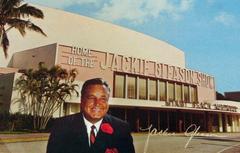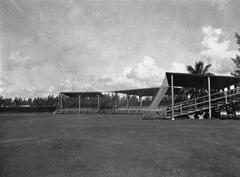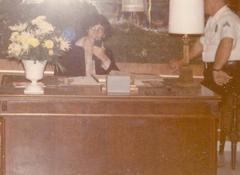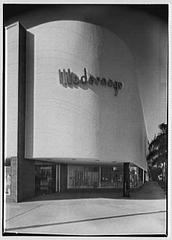Holocaust Memorial Of The Greater Miami Jewish Federation
Holocaust Memorial Greater Miami: Visiting Hours, Tickets, and Visitor Guide
Date: 15/06/2025
Introduction
The Holocaust Memorial Miami Beach, officially known as the Holocaust Memorial of the Greater Miami Jewish Federation, is one of the most significant Holocaust memorials in the United States. Located at 1933–1945 Meridian Avenue—a symbolic address echoing the years of the Nazi regime—it honors the six million Jewish victims and millions of other innocent people lost during the Holocaust. Conceived in the 1980s by survivors who made Miami Beach their home, the memorial is a vital center of remembrance, education, and community engagement. Its evocative architecture, designed by Kenneth Treister, invites visitors on a powerful journey of reflection, remembrance, and hope.
This comprehensive guide details the Holocaust Memorial’s history, architectural significance, educational initiatives, visitor information (including hours and ticketing), accessibility, nearby attractions, ongoing preservation, and practical tips to make your visit meaningful. Whether you are a local, a student, or a first-time visitor, the Memorial offers a transformative experience rooted in history and dedicated to promoting tolerance and understanding.
History and Origins
The idea for the Holocaust Memorial Miami Beach began in the mid-1980s, spearheaded by Holocaust survivors living in Miami Beach who sought a lasting tribute to those lost and a resource for education. Formally established in 1985, the committee led fundraising, site selection, and the commissioning of Kenneth Treister to design the memorial. The site’s address, 1933–1945 Meridian Avenue, was deliberately chosen to symbolize the years of the Holocaust (Miami Beach City PDF), (cja.huji.ac.il).
Dedicated on February 4, 1990, with Nobel laureate Elie Wiesel as keynote speaker, the memorial quickly became a cornerstone of Miami Beach’s cultural and historical landscape, welcoming millions of visitors from around the world.
Architectural and Artistic Significance
The Journey Through the Memorial
Kenneth Treister’s design guides visitors through a sequence of outdoor spaces, each imbued with symbolism and emotion. Entering through Jerusalem stone walls inscribed with concentration camp names, visitors encounter a procession of historical and contemplative areas: a reflecting pool, meditation garden, and memorial wall. The memorial’s layout intentionally evokes feelings of confinement and loss, balanced by open spaces that invite reflection (Miami and Beaches), (cja.huji.ac.il).
The Central Sculpture: “Sculpture of Love and Anguish”
At the memorial’s heart is a monumental 42-foot bronze arm stretching skyward, tattooed with an Auschwitz number that was never issued—symbolizing victims whose names and numbers were lost to history. Surrounding the arm are more than 100 individually hued bronze figures representing men, women, and children in states of suffering, despair, and hope (Lonely Planet), (cja.huji.ac.il).
The reflecting pool and Jerusalem stone walls further enhance the memorial’s atmosphere, creating a space that is both solemn and contemplative. Engraved throughout the site are the names of victims, offering survivors and their families a place to remember loved ones.
Educational Initiatives and Partnerships
Education is at the core of the memorial’s mission. The site collaborates with local and international institutions, including Yad Vashem’s International School for Holocaust Studies, to train educators and develop impactful programs (Holocaust Memorial Miami Beach Programs). Teachers participate in intensive training in Israel and bring their knowledge back to local classrooms.
Other key educational programs include:
- Young Lion of Judah Program: Pairs B’nai Mitzvah students with survivors for intergenerational learning.
- Professional Development: For educators and docents, ensuring up-to-date, effective Holocaust education.
- School Partnerships: Miami-Dade County Public Schools and others bring over 90,000 students annually for tours and educational events.
- Public Events: Film screenings, lectures, survivor testimonies, and annual commemorations such as Holocaust Remembrance Day and Kristallnacht (Holocaust Memorial Miami Beach), (JCSFL Blog), (3GMiami).
Visiting Hours, Tickets, and Admission
- Hours: Open daily from 9:30 AM (or 10:00 AM in some sources) until sunset (holocaustmemorialmiamibeach.org), (whattodomiami.com).
- Admission: Free for all visitors; donations are appreciated to support educational programs and maintenance.
- Guided Tours: Available for groups (10+ people) with advance reservation; self-guided tour brochures are available on-site for a small donation.
- Contact: For tours or accessibility needs, call 305-538-1663.
Accessibility and Visitor Amenities
- Physical Accessibility: The memorial is fully accessible, with level paths suitable for wheelchairs and strollers (holocaustmemorialmiamibeach.org).
- Wheelchair Availability: Wheelchairs can be reserved in advance.
- Sign Language: American Sign Language interpreters available by prior request.
- Facilities: The memorial is primarily outdoors; limited restroom facilities are available nearby. Shaded areas and benches provide comfort.
- Parking: Free parking is available close to the site; public transportation options include the 123-South Beach Local bus route.
Travel Tips and Nearby Attractions
- Best Time to Visit: Early morning for quiet reflection; dress for Miami’s warm climate and bring water.
- Photography: Allowed throughout the memorial; be respectful of the solemn setting (rachelsruminations.com).
- Nearby Sites: Miami Beach Botanical Garden, Art Deco Historic District, Bass Museum of Art, Jewish Museum of Florida-FIU (mikeandlauratravel.com), (whichmuseum.com).
- Combining Visits: Pair your visit with other cultural landmarks for a broader experience.
Ongoing Preservation and Community Engagement
The memorial is a living site, requiring ongoing care and capital improvements, including structural repairs, bronze repatination, stonework maintenance, and security upgrades (Miami Beach City PDF). These efforts are sustained through city funding, philanthropy (such as the Zachor Society), and volunteerism.
Community members can contribute by volunteering, joining educational programs, or donating to preservation projects.
Events, Commemorations, and Cultural Impact
The Memorial hosts significant events throughout the year, including Holocaust Education Week, survivor talks, film screenings, and candlelight vigils (JCSFL Blog). These programs foster collective memory, intergenerational dialogue, and community solidarity.
The Memorial is also recognized for shaping Miami Beach’s cultural identity, highlighting the profound influence of Holocaust survivors and their descendants on the city’s evolution (Tripexpert).
Frequently Asked Questions (FAQ)
Q: What are the visiting hours?
A: Open daily from 9:30 or 10:00 AM to sunset, depending on the time of year and source.
Q: Is admission free?
A: Yes, admission is free; donations are appreciated.
Q: Are guided tours available?
A: Yes, for groups of 10 or more with advance reservation; self-guided brochures are available.
Q: Is the memorial accessible for people with disabilities?
A: Yes, fully accessible, with wheelchairs and interpreters available by request.
Q: Can I take photographs?
A: Yes, but please be respectful.
Q: What are the nearby attractions?
A: Miami Beach Botanical Garden, Art Deco Historic District, Bass Museum of Art, Jewish Museum of Florida-FIU.
Visuals and Media
For a richer experience, visit the memorial’s official website for virtual tours and high-resolution images. Recommended photographic spots include the central bronze sculpture, reflecting pool at sunset, and Jerusalem stone walls. Use descriptive alt-text for online images such as “Holocaust Memorial Miami Beach bronze arm sculpture” to improve accessibility and SEO.
Conclusion and Call to Action
The Holocaust Memorial Miami Beach stands as a vital space for remembrance, education, and the cultivation of tolerance. Its artistic and educational programs, free public access, and ongoing community engagement ensure the legacy of Holocaust victims and survivors endures for future generations. Whether you come to honor loved ones, learn about history, or reflect on the consequences of hatred, the Memorial offers a transformative journey.
To enhance your visit, download the Audiala app for guided audio tours and exclusive multimedia content. Stay updated on events and volunteer opportunities by following the Memorial’s official social media channels.
For the latest visiting hours, educational resources, and event updates, visit the Holocaust Memorial Miami Beach official website and consult these authoritative sources:
- Holocaust Memorial Miami Beach Programs
- Miami Beach City PDF
- Miami and Beaches
- Central Jewish Archives
- What To Do Miami
- Jewish Community Services of South Florida





